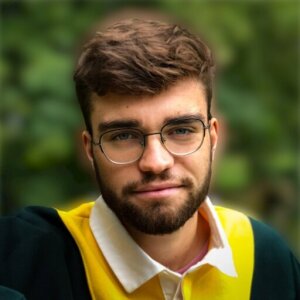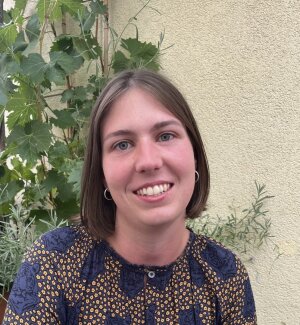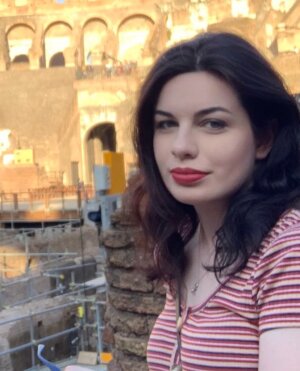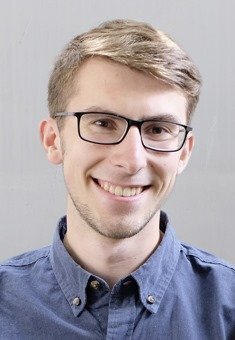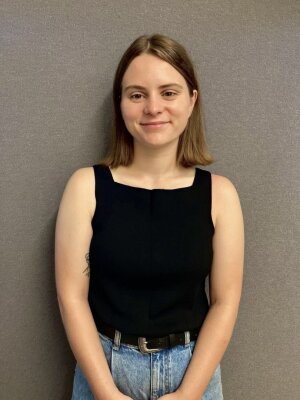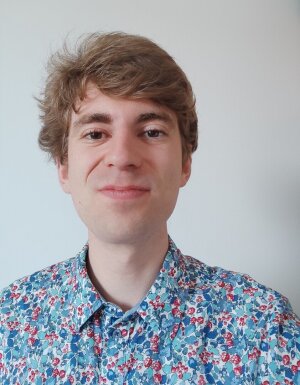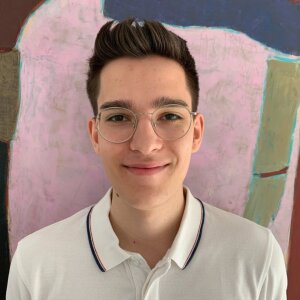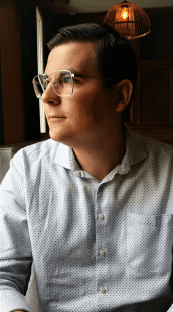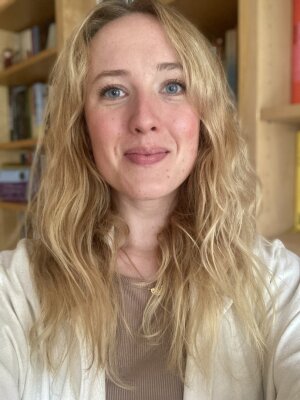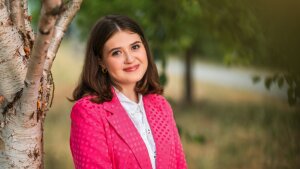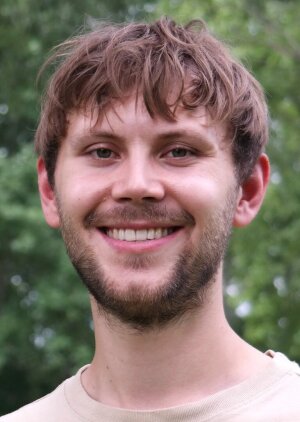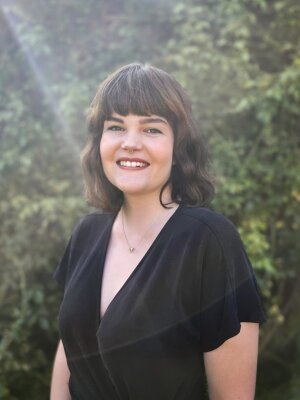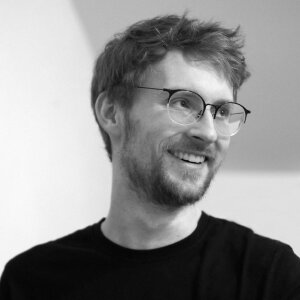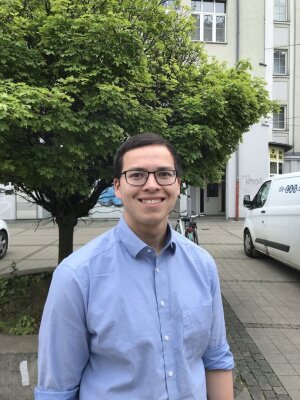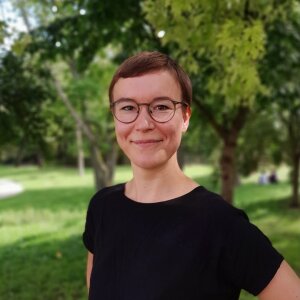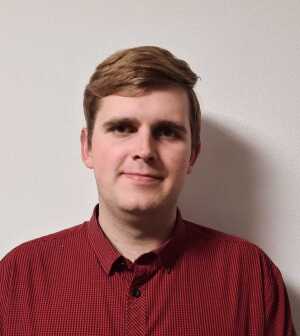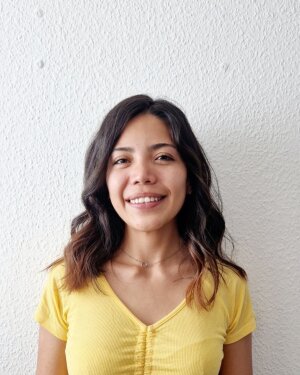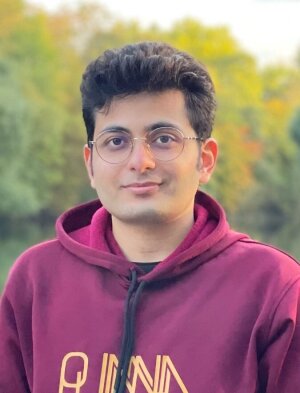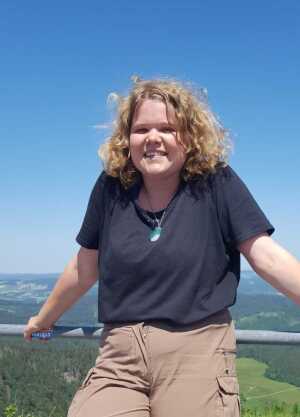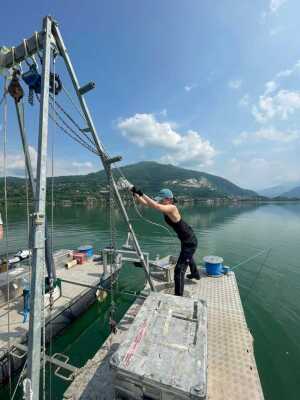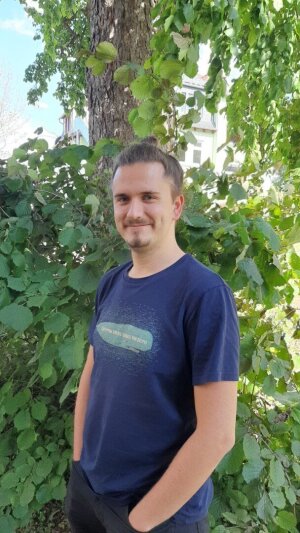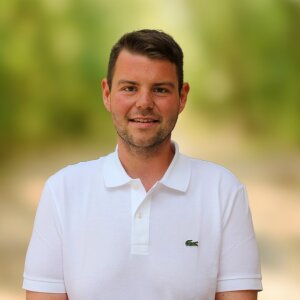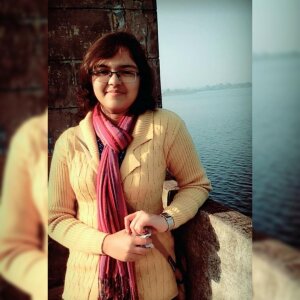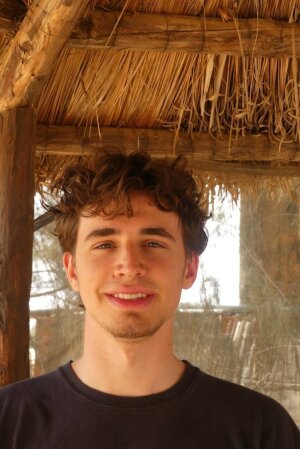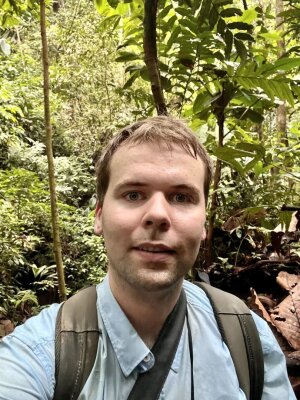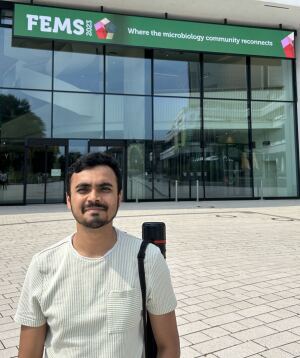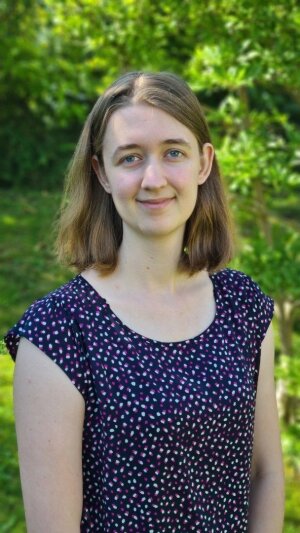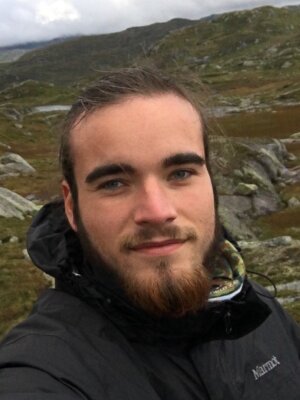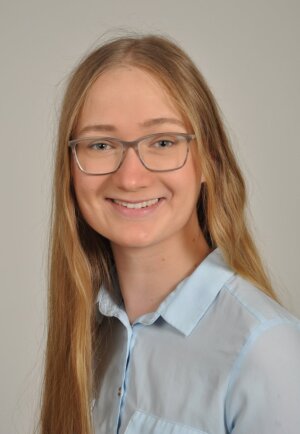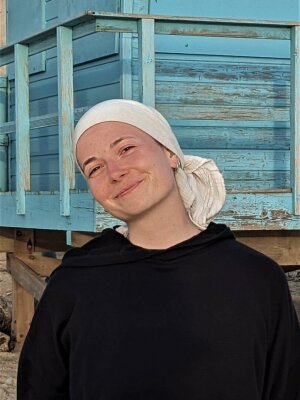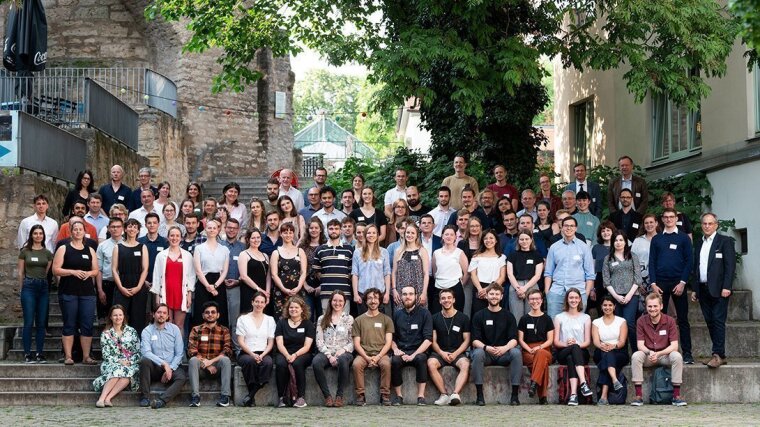
In July 2023, 64 students were accepted into the programme. On 04.07.2023, we welcomed the students and their supervisors at the opening ceremony.
Impressions from the opening ceremony
-
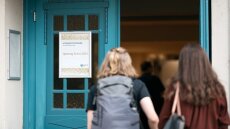
Arrival of the Honours students
Image: Christoph Worsch (University of Jena) -

Arrival of the Honours students and their supervisors
Image: Christoph Worsch (University of Jena) -

Arrival of the Honours students and their supervisors
Image: Christoph Worsch (University of Jena) -
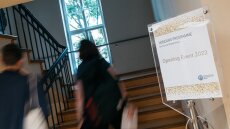
Arrival of the Honours students
Image: Christoph Worsch (University of Jena) -

Arrival of the Honours students
Image: Christoph Worsch (University of Jena) -
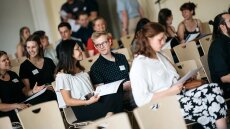
Arrival of the honours students
Image: Christoph Worsch (University of Jena) -

Honours guidelines
Image: Christoph Worsch (University of Jena) -
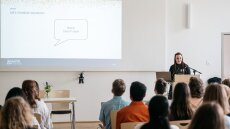
Welcoming of the Honours students by the coordinator of the programme, Dr Dörte Meeßen
Image: Christoph Worsch (University of Jena) -
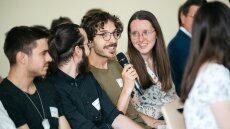
Introduction of the Honours students
Image: Christoph Worsch (University of Jena) -
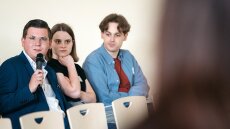
Introduction of the Honours students
Image: Christoph Worsch (University of Jena) -
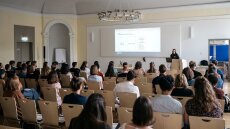
Session for the honours students
Image: Christoph Worsch (University of Jena) -
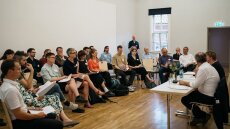
Session for the supervisors
Image: Christoph Worsch (University of Jena)
Faculty of Law
-
Florian Wagner
Course of study: Law (state examination)
Supervised by Prof. Dr. Matthias Knauff
The role of the public in implementing the energy transition – Legal instruments and challenges –
The energy transition is one of the central issues of our time and necessary to achieve the goal of greenhouse gas neutrality in 2045. For its implementation, the acceptance of the public, that means the citizens, is essential. In this context, I investigate in my research project what contribution law makes and can make in order to achieve public acceptance and, in the best case, public support and thereby contribute to the speedy implementation of the energy transition. To this end, I will throw light on whether and, if so, what requirements higher-level European and constitutional law place on the involvement of the public in energy transition projects. In addition, current legal approaches to public participation and other relevant instruments will be presented, analysed and evaluated. These arise in particular from sectoral planning law and the law on renewable energies. Finally, possible perspectives and proposals for change will be outlined, taking into account the insights gained.
Contact:
f.wagner@uni-jena.de -
Moritz Weiß
Course of study: Law (state examination)
Supervised by Prof. Dr. Achim Seifert
Education for Socialism through the Law in the GDR: The Residential Tenancy Law of the GDR as an Example
My project examines the hitherto little researched residential tenancy law of the German Democratic Republic (GDR). Using this example, the aim is to illustrate that the legal system also had an educational function. Against this backdrop, the question arises as to how conflicts related to tenancies were resolved. In addition to state jurisdiction, the focus of the study is on “social courts”, with “Konfliktkommissionen” (Disputes Commissions) serving as an example. These courts are composed of the workers from the enterprises. Another focus concerns the participation of tenants in decision-making processes. This raises the question of the extent to which organizational forms such as the “Mietergemeinschaft" (Community of Tenants) promoted the implementation of socialist moral concepts. By evaluating court decisions and other historical sources, this research aims to provide insights into the legal specifics of the GDR and the differences compared to the FRG.
Contact:
moritz.weiss@uni-jena.de
Faculty of Economics ans Business Administration
-
Anna Luise Marie Mahar
Course of study: Economics and Business Administration (M. Sc.)
Supervised by Prof. Dr. Peter Walgenbach
The managerialization of higher education institutions: An examination of changes in the governance structure of higher education institutions in Germany
The education and science sector has undergone major changes in recent years and faces a variety of challenges. Universities are exposed to increasing competitive pressure at national and international levels. As a reaction, the strategic orientation of higher education institutions has changed in such a way that new focus areas beyond the core tasks (research and teaching) have been identified (e.g. sustainability) and an increasing alignment of the structural and management elements of higher education institutions with those of private companies can be observed (managerialization). The research project is intended to contribute to a better understanding of the developments of higher education institutions and to be able to comprehend the resulting changes in the competencies of decision-making within higher education institutions. For this, we will examine how the differentiation of the management structure of German higher education institutions currently presents itself and how potential differences can be explained.
-
Hannes Rühlemann
Hannes Rühlemann
Image: Hannes RühlemannCourse of study: Economics and Business Administration (B. Sc.)
Supervised by Prof. Dr. Silke Übelmesser
Asset Composition in Germany: Analysis of Regional Differences (East/West, Urban/Rural)
Despite Germany's continuous economic growth, significant wealth disparities are evident, especially between East and West as well as urban and rural areas. Historical and structural reasons, as emphasized in the annual report from the Federal Ministry for Economic Affairs and Energy (2019), play a central role. My research, based on a survey from the Chair of Public Finance (Prof. Dr. Übelmesser) in March 2023, examines the asset composition across various categories. The goal is to identify regional disparities (East/West, Urban/Rural) and the influence of sociodemographic factors such as income, gender, and education on weatlh. This investigation seeks to offer in-depth insights into Germany's wealth distribution and provide empirical data for policymakers.
Contact:
hannes.ruehlemann@uni-jena.de -
Jan Laufing
Jan Laufing
Image: Nico LaufingCourse of study: Economics and Business Administration (B. Sc.)
Supervised by Prof. Dr. Silke Übelmesser
Text Analysis as a tool to evaluate open survey questions
In a digital world, organizations face large amounts of data. About 80% of enterprise data is unstructured, according to estimates by the International Data Corporation. Text data is one of them, as it is difficult to aggregate and analyze. In business, text analysis helps to understand customer feedback, identify trends, and improve products. Data comes from interviews, social media, emails, and direct corporate communications. Text analysis is also relevant in science. Open-ended questions in surveys prevent response limitations and provide insights into motivations and thoughts. Open-ended responses can validate closed-ended question results. My research goal is to discuss the advantages and disadvantages of text analysis, present trends and to use my own text analysis program with data from a survey, conducted by the Chair of Public Finance of the University of Jena. This survey will analyze factors for study choice decisions in the business faculty in order to attract new students. This supports the student recruitment efforts of the faculty at the University of Jena.
Contact:
jan.laufing@uni-jena.de
Faculty of Arts
-
Celina Bausewein
Celina Bausewein
Image: Celina BauseweinCourse of study: German, Latin, German as a second and foreign language (LA Gymnasium, state examination)
Supervised by Dr. Nimet Tan
School integration of newly immigrated children and young people in Thuringia
The research project focuses on explaining and visualising multilingualism and its promotion in schools in Thuringia. On the one hand, the focus is on the schooling and integration of children and young people who have recently immigrated from abroad and are integrated into the German education system as so-called lateral entrants. On the other hand, the focus is on supporting and dealing with the multilingualism of pupils in schools in Thuringia. In 2022, more than 10,000 children and young people of school age came to Thuringia as a result of the war - a strong upward trend. Within the framework of qualitative interview research, the primary question to be addressed is what school integration and migration-related heterogeneity mean in the context of (school) teaching, and how the concrete practical implementation of administrative-curricular guidelines and recommendations for the promotion of the target language(s) and mother tongue(s) is currently organised in the state of Thuringia.
Contact:
celina.bausewein@uni-jena.de -
Torben Bunzenthal
Course of study: Art History and Film Studies (M. A.)
Supervised by Prof. Dr. Bernhard Groß
Film as an art form at the documenta 1955
The documenta, which takes place regularly in Kassel, considers itself as one of the world's most important exhibitions of contemporary art. A film programme was already part of the exhibition at the first documenta in 1955. This fact has fallen into oblivion. The film programme under the title "Film - Documents from 40 Years" was intended by the curators to complement the works of visual art. This is particularly remarkable because film was not always understood as art in public discourse at the time. Thus, the medium was also to be ignored in the following three exhibitions. What motivated the makers of the first documenta to show films at the exhibition? What kind of films were shown? By whom and according to what criteria were the films selected? What were the reactions of the public and the experts? Using the holdings of the documenta archive, I would like to open up new perspectives on the medium of film as an art form.
-
Elodie El-Hossanini-Sacher
Course of study: Art History and Film Studies (M. A.)
Supervised by Prof. Dr. Juliane von Fircks
Allāh. al-Waṭan. al-Malik. (Allah, Fatherland, King): the image politics of the ʿAlawī ruler portraits from Mawlāy ʿAbd al-ʿAzīz to Mohammed VI.
Contact:
elodie.sacher@uni-jena.de -
Narmin Gurbanova
Narmin Gurbanova
Image: Narmin GurbanovaCourse of study: Caucasian Studies (M. A.)
Supervised by Prof. Dr. Diana Forker
Study of indigenous rituals in Northern Azerbaijan
Globalization continues to stretch out into the most remote regions of the world and urges its communities to conform to modernity. And albeit this process has many merits, it is important to combine it with cultural preservation. The aim of my project is thus to document, describe and analyze rituals in Northern Azerbaijan (specifically, pagan wedding traditions within Lezgian and Avar communities). During this field research, it is to be determined if the communities are still practising the rituals, described in the previous centuries if they have abandoned them, or transformed into different shapes. The newer data should help establish how endangered the cultural heritage of indigenous Caucasians is and what further steps should be taken to prevent definitive loss.
Contact:
narmin.gurbanova@uni-jena.de -
Käthe Sophie Hanschmann
Course of study: Latein (LA Gymnasium, state examinatin)
Supervised by Prof. Dr. Susanne Daub
Content bindingness of diary notes when their author's perspective changes – a case study from the 17th century.
The Jesuits Daniel Papebroch and Gotfrid Henschen traveled through Europe in 1660-1662 to collect information about saints and their places of worship. This material shall be used to compile a historical-critical complete edition of all saints' vites, the so-called Acta Sanctorum. This journey is documented by Papebroch in a diary. When Jean Bolland, who as the founder of the Acta Sanctorum originally wanted to make the journey himself, died in 1665, Papebroch wrote an obituary for him and briefly summarized the journey in it. This paraphrase is the text I want to examine in my project. I want to translate it, write an historical commentary and compare it with the related diary entries. It is particularly interesting to see which contents of the diary the author himself refers back to and in which way he uses them.
-
Felix Herold
Felix Herold
Image: Stephanie SabirCourse of study: Indo-European Studies/Romance Studies
Supervised by Prof. Dr. Martin Joachim Kümmel
How much text can be found in individual words?
Normally, texts are analysed in terms of their content mostly in literary studies. Linguistics, on the other hand, is often only consulted when a classification according to authorship, a chronological or details of etymologies need to be clarified. Linguistics can also contribute to content analysis - considering, for example, the tendency towards impersonal or passivised formulations or the reduction of evaluative vocabulary in specialised texts. The aim of my project is to use the sum of word analyses of texts to statistically define genre boundaries and allocations to certain authors will be made statistically ascertainable. For languages with a strongly synthetic linguistic structure, in which case and number markings are clearly visible by morphemes, such as in ancient Greek or Sanskrit. These findings can lead to a comparison of the two different languages - for example, from the point of view of the genre boundaries of different text types.
Kontakt:
felix.herold@uni-jena.de -
Sophie-Marie Hohmann
Sophie-Marie Hohmann
Image: Maximilian SchillCourse of study: History and Politics of the 20th Century (M. A.)
Supervised by Prof. Dr. Stefanie Middendorf
The dimensions of the violent persecution of Sinti*zze and Rom*nja in Thuringia during the Weimar Republic and National Socialism
Racist behaviour against Sinti*zze and Rom*nja, which is mostly summarised under the term "Antiziganism", is a historical as well as a contemporary topic, which is still supported by a broad social acceptance in Germany. Within my research project, I would like to investigate the historical dimensions and continuities of this history of antiziganist violence based on the history of persecution of Sinti*zze and Rom*nja in the area of today’s Thuringia. The study begins at the time of the Weimar Republic when the police persecution of Sinti*zze and Rom*nja intensified as a result of the founding of Thuringia in 1920. The thesis focuses on the reviewing of the National Socialist persecution of the Sinti*zze and Rom*nja living in Thuringia. Following a micro-historical research approach, the study pursues the question of which dimensions of violence Sinti*zze and Rom*nja were exposed to during the Weimar Republic and National Socialism in Thuringia and which actors, ways of thinking and acting were significant in it.
Contact:
sophie-marie.hohmann@uni-jena.de -
Fabian Hoinkis
Fabian Hoinkis
Image: Fabian HoinkisCourse of study: Cultural Anthropology/History of Culture (M. A.)
Supervised by Prof. Dr. Anja Laukötter
The Colonial Exhibition in Jena around 1900 – A local history of colonialism
Around 1900, large exhibitions took place in various cities to support the idea of a German domination in parts of Africa, China and Oceania. But what about the university and industrial city of Jena? By analyzing the Colonial Exhibition of Jena, I will research the city´s colonial past that was embedded in networks of societies, companies and people. In 1900 the exhibition took place in the university´s “Rosensäle”. It was organized by the local Geographic Society and opened by the then-prominent zoologist and evolution biologist Ernst Haeckel. In the exhibition visitors found a composition of model ships, everyday objects, stuffed animals, plants, and a supposed rebuilding of an “African village”. Which colonial fantasies were materialized in the exhibition? Which narratives were told about the German colonies? Which aspects were made visible, which invisible, for example regarding colonial violence? With my project, I would like to open new perspectives on colonial heritage in Thuringia.
Contact:
fabian.hoinkis@uni-jena.de -
Jonas Krause
Jonas Krause
Image: Jonas KrauseCourse of study: German/English (LA Gymnasium, state examination)
Supervised by Prof. Dr. Iris Winkler
Extracurricular Teaching Activities in the Subject of German
Germany is affected by a shortage of teachers. This is also noticeable at universities, where there are teacher-training students already working as part-time teachers in schools. As the side jobs of students, their involvement as teachers in schools, and their teaching practices are not extensively researched, this project aims to gain insights into the attitudes and teaching of these students and to examine them from a subject-specific didactic perspective. In a first step, teacher training students in German studies have been surveyed through a questionnaire about their extracurricular teaching activities, their motivations for engaging in them, their attitudes and perspectives on aspects such as the relationship between theory and practice, and more. In a second step, an interview study will be conducted to ask participants more detailed questions about their extracurricular activities, their perceptions of the teacher training program in German studies, as well as their teaching practices and principles.
Contact:
jonas.krause@uni-jena.de -
Leon Kresin
Course of study: History (B. A.)
Supervised by Prof. Dr. Timo Stickler
Polycrates of Samos – A local ruler on the periphery of the Persian Empire
-
Ulrike Lade
Course of study: Art History and Film Studies (M. A.)
Supervised by Prof. Dr. Juliane von Fircks
Knitting in the Middle Ages – Is it Art? An Art Historical Examination of Medieval Knitted Objects
-
Chia-Wei Lin
Course of study: Indo-European Studies, Arabic Studies
Supervised by Prof. Dr. Peter Stein
The Buddha's Journey to the West: Barlaam and Josaphat in the Eurasian Linguistic Context
Barlaam and Josaphat (BJ) is the epitome of medieval transcultural, interreligious, cross-linguistic phenomena that took place on the Eurasian continent and beyond. BJ is a collection of the Buddha's life stories originating in India, which have circulated widely in the medieval Middle East and Europe. The stories represent a syncretic version of the Buddha's biography, whose parallels are preserved in the Sanskrit, Pali, Tibetan, and Chinese Buddhist canon. BJ was first translated into Middle Persian, subsequently Arabic, Georgian, Greek, Latin, and most European vernaculars. When Jesuit missionaries arrived in China and Japan in the 16th century, they brought the stories of Saint Barlaam and Saint Josaphat along and translated these into early modern Chinese and Japanese, creating cultural "doublets" of the Buddha's biography in Asia. The project will establish a synoptic edition of core translations of BJ's western transmission (Arabic, Georgian, Greek) and observe how key Buddhist elements, terms, and phraseology are linguistically and culturally transformed in the process of translation.
-
Alexander Litvinenko
Alexander Livinenko
Image: Karoline KühnCourse of study: History and Politics of the 20th Century (M. A.)
Supervised by Prof. Dr. Annette Weinke
The "Sonderedition Deutsche Einheit" from 1998. File policy of the Federal Chancellery after reunification
Due to the great scientific and public interest in the reunification process at home and abroad, the Federal Chancellery approached renowned representatives of German historical scholarship in 1995 with the request to prepare an edited publication of the files. Long before the expiration of the usual embargo period for official archive material, 430 government files, primarily from the period between the fall of the Berlin Wall and the implementation of the unification treaties, found their way into the special edition of over 1,500 pages, which was published three years later as the conclusion of the series Dokumente zur Deutschlandpolitik (DzD). Under the scientific direction of the historians Hans-Peter Schwarz and Klaus Hildebrand as well as by an editing group coordinated by Hanns-Jürgen Küsters, the concrete selection and classification of the key documents began, with the participation of the Bundesarchiv, with the aim of reconstructing the reunification process from the perspective of the Chancellor's Office as the German decision-making center. Based on historiographical criteria, the edition initiated by the Chancellery, raises a number of research questions. The aim of the project is to classify and analyze the genesis of the edition in the context of German file and release policy after reunification. In addition to examining the underlying editing criteria and the associated intentions and expectations, the concrete creation and contemporary reception of the edition in academia and the media will be considered.
Current publication: "Im Schatten von Russlands Ukrainekrieg: der Zwei-plus-Vier-Vertrag in Gefahr?External link".
-
Henrike Münch
Henrike Münch
Image: Henrike MünchCourse of study: English/German (LA, Gymnasium, state examination)
Supervised by Dr. Silke Braselmann
Teacher and Climate Activist? – An Empirical Study on the Professional Self-Concept of Thuringian English Teachers in the Context of Global Education
Within the field of language didactics, the topic of global education has come to play an important role. English as a subject is particularly suitable to foster global education and there are a number of publications that present pedagogical approaches and didactic models on how to incorporate this topic into the classroom. One common element in most of these models is the objective of encouraging and enabling students to take real-world action. This emphasis on taking action also raises questions about teachers’ activism. My project focuses on the professional self-concept of teachers regarding activism and the forms of activism that can be found in Thuringian schools today. Using the example of climate activism, I will investigate how individual teachers define activism, what their attitudes are towards activism inside and outside the classroom and whether they feel the responsibility of taking the role of an activist in the context of global education.
Contact:
henrike.muench@uni-jena.de -
Laura Bella Theis
Laura Bella Theis
Image: Manuel GlatterCourse of study: Literatur-Kunst-Kultur (M.A.)
Supervised by Prof. Dr. Alice Stašková
An Art of confrontation? On the cultivation of an active attitude towards the world within the framework of Friedrich Schiller's aesthetics
This interdisciplinary research project focuses primarily on the relationship between Friedrich Schiller's philosophy of consciousness and his theory of the sublime. Beauty and sublimity enable freedom in the field of tension between reason and sensuality as well as activity and passivity. In the light of Schiller's philosophy of consciousness, the cultivation of these feelings is presented as granting liberation from the world and at the same time allowing participation as part of the world. I will address the question of how 'tragic art' can convey freedom and thus indirectly promote morality. This also provides an opportunity to work out the extent to which Schiller's early reflections on the interrelation between the attitude of reception and the conception of the figure prepare the basis for later assumptions about the relationship between the person and the world. The object of investigation is Schiller's own selection of texts from the third part of the 'Kleinere prosaische Schriften', in which he presented a new 'architecture' of his theory of aesthetics in 1801.
Thanks for the kind support of: Prof. Dr. Andrea Marlen Esser, Dr. Peggy Hetmank-Breitenstein, Nichita Doroshenko (M.A.) and Niklas Sommer (M.A.)
Contact:
laura.bella.theis@uni-jena.de -
Wanda Sue Warning
Course of study: Art History and Film Studies (M. A.)
Supervised by Prof. Dr. Johannes Grave
Portraits of the Unknown. A comparative study of Fancy Pictures, Tronies, Character Heads and other Portrait Series of Unknown (Fantasy-) Figures
Faculty of Social and Behavioural Sciences
-
Emily Ahrens
Course of study: Political communication (M. A.)
Supervised by Prof. Dr. Tobias Rothmund
Differentiating and Characterizing Online Users in Response to Incivility: A Latent Profile Analysis
In my project, I deal with the classification of different groups of people in connection with online incivility. Online incivility can be understood as an umbrella term for violations of general communicative norms by users on the Internet. Since online incivility can have negative effects on individuals as well as on the political discourse online, this project aims to gain new insights for prevention research. In order to find out if there are different user types based on behaviours, attitudes and experiences regarding incivility, a latent profile analysis will be conducted. With the help of a latent profile analysis, patterns in a data set can be made visible that only occur when several predictor variables are considered simultaneously. The profiles developed are additionally described using other variables (demographics, emotional reactions to incivility, and social dominance orientation) to provide additional evidence for future prevention approaches.
Contact:
emily.ahrens@uni-jena.de -
Sophia Bader
Course of study: Soziologie (M. A.)
Supervised by Prof. Dr. Klaus Dörre
Healthcare Personnel Caught between Symbolic Recognition and Material Legitimacy Struggles: The Hospital Movement of North Rhine-Westfalia as a Microcosm for Unionization in Germany – A Cartography
Ever since the emergence of Covid-19, clinical staff have voiced concerns regarding their arduous working conditions. Particularly noteworthy are the pervasive issues of inadequate staffing in many places, resulting in the burden of excessive overtime and posing substantial health risks for both patients and caregivers. Moreover, the commendable yet demanding nature of their work is met with remuneration that has long been deemed insufficient, a matter that has garnered public attention for years. In the year 2022, the healthcare movement in North Rhine-Westphalia underscored these challenges through an impactful 77-day strike, culminating in the attainment of an agreement aimed at alleviating these pressures. This qualitative research endeavour delves into a comprehensive exploration of this movement, with a specific focus on its organisational dynamics, particularly within the realm of labour unions, as well as its potential to instigate progressive transformations. Employing a diverse range of semi-structured interviews, this study endeavours to craft a multifaceted portrait of the healthcare movement. It seeks to delineate the various stakeholders involved and elucidate the pivotal factors contributing to its achievements. Additionally, the intricate processes of organisation and consciousness-raising that have unfolded within this movement shall be investigated.
-
Helene Franke
Course of study: Political Science (M. A.)
Supervised by Prof. Dr. Marion Reiser
The Network of the New Right
-
Wanda Gehrt
Course of study: Sociology (M. A.)
Supervised by Dr. Mike Laufenberg
Conformist rebellion – right-wing attitudes as authoritarian mode of stabilizing the self
The fact that the strengthening of manifest authoritarian attitudes has to do with the precarisation of working and living conditions and feelings of insecurity and deprivation is now undisputed, albeit with different nuances and emphases. At the same time, these explanatory approaches come to limits, as it often remains unclear why (perceived) deprivation makes right-wing attitudes attractive. Based on this, I would like to use my research project to explore the question of how the (threat of) deprivation is countered and what role authoritarian attitudes play in this. To this end, in-depth hermeneutic case reconstructions will be carried out, which will make it possible to move away from the specific psychological processes of the interviewees to general social structures.
-
Moritz Harzbecher
Moritz Harzbecher
Image: Moritz HarzbecherCourse of study: Sociology (M. A.)
Supervised by Dr. Jörg Oberthür
Urban sprawl as a source of conflict in socio-ecological transformation
The project investigates conflicts around the globally observable phenomenon of "urban sprawl". Urban sprawl describes the disorderly spread of settlements and infrastructure into the often agriculturally used surrounding countryside. In recent years, protest movements against urban sprawl have increased. The project follows the basic thesis that urban sprawl is not only a specific building practice, but also anchored in the minds of people and the structure of society. This can be seen, for example, in the widespread desire for a "little house in the countryside" as well as in the financial incentives for municipalities to designate new residential and commercial areas. Protest against urban sprawl thus inevitably calls into question the social ideas, ideals and habits associated with it. A case study will be used to empirically reconstruct the associated conflicts, the groups of actors involved in them, and the alternatives they put forward.
Contact:
mharzbecher@aol.de -
Marc-Dirk Harzendorf
Course of study: Sociology (M. A.)
Supervised by Prof. Dr. Klaus Dörre
Economization – Privatization – Precarization: The Exploration of the Healthcare System as an Industry
-
Anna Lydia Kahle
Course of study: Psychology (M. Sc.)
Supervised by Prof. Dr. Ilona Croy
Protective factors of mental health
Major Depression is one of the most diagnosed mental disorders. Therefore, research on the causes, predisposing, and maintaining factors of depression is highly relevant. Researchers found that self-esteem might be a possible factor that makes people vulnerable to affective disorders. Moreover, the quality and quantity of social interaction could play a crucial role. The aim of this project at the Department of Clinical Psychology is to investigate those correlations further. A better understanding of the connections between depression, self-esteem, and social inclusion is of special interest. Findings could be of great scientific relevance, as knowledge about the connections could help to identify a person at high risk in screenings and initiate prevention early. In the long term, this could represent an approach for early recognition of mental illnesses, which would help to reduce severe and chronic courses.
Contact:
anna.lydia.kahle@uni-jena.de -
Freyja Krull
Course of study: Psychology (M. A.)
Supervised by Prof. Dr. Ilona Croy
Movement synchronization in psychotherapeutic interactions
During a psychotherapeutic session, therapist and patient interact not only verbally, but also nonverbally. One type of nonverbal interaction takes place through body movements. Thereby the interaction partners influence each other in their body movements. The aim of this work is to find out if and how these interactions behave over the course of therapy and influence the therapeutic process and its results. Different ways of analysing body movements during a session will be tested. The project is part of psychotherapy research, specifically the study of therapeutic processes and mechanisms of action in psychotherapy at the Department of Clinical Psychology.
Contact:
freyja.krull@uni-jena.de -
Stefan Schmidt
Stefan Schmidt
Image: University of Rhode Island, RI, USACourse of study: Psychology (M. Sc.)
Supervised by PD Dr. Gerd Wagner
The Subjective Experience of Compulsion
With a lifetime prevalence of 2-3%, OCD is one of the most common mental disorders in the population. A core symptom of OCD is the experienced loss of control over one's own thoughts and actions. This negative experience is often compensated by ritualized actions and thoughts. To date, however, it is unclear whether and how the experience of loss of one's own control is altered in the context of the disorder and contributes to its development or clinical manifestation. The aim of this project, which is conducted at the Department of Psychiatry and Psychotherapy of the University Hospital Jena, is to extend existing metacognitive and cognitive explanatory models of OCD by two sensorimotor theories, Excessive Conscious Monitoring and Seeking Proxies for Internal States, in order to explain action-related features of individuals with OCD, such as the feeling of incompleteness of action and repetitiveness.
Contact:
stefan.schmidt@uni-jena.de -
Lea Schnackenberg
Lea Schnackenberg
Image: Lea SchnackenbergCourse of study: Sociology (M. A.)
Supervised by Prof. Dr. Stefanie Hiß
Future vision: The production of green hydrogen in Thuringia
Facing the climate crisis, it is necessary to move away from carbon-intensive technologies - especially in the energy sector. In this respect, the research and use of hydrogen-based solutions is becoming increasingly important. As a power-to-gas technology, hydrogen (H2) belongs to the so-called power-to-X technologies, i.e. it is an energy carrier (X) that is produced from electricity (power). The hydrogen currently produced in Germany is mostly a by-product of industry, but the construction of green hydrogen production facilities in Germany is also being discussed. This H2 would then be produced with the help of electricity generated from renewable energies. Inspired by transition research, the project looks at the acceptance of green hydrogen production in Thuringia and tries to identify challenges and opportunities. A special focus is on the socio-political acceptance of political decision-makers because they set the framework conditions for the use of new technologies and thus contribute significantly to the success or failure of an innovation.
-
Christoph Stieglbauer
Christoph Martin Stieglbauer
Image: Christoph Martin StieglbauerCourse of study: International Organizations and Crisis Management (M.A.)
Supervised by Prof. Dr. Christian Kreuder-Sonnen
Internal contestation of informal intergovernmental organizations
My project deals with international organizations (IOs) and their interactions with states. Powerful IOs are increasingly challenged and contested by their member states. So far, this internal contestation of IOs has been studied exclusively in the context of formal IOs such as the United Nations or the European Union. Formal IOs are based on an international treaty and enjoy the support of a permanent secretariat. However, global governance is shaped more and more by informal IOs such as the G7 or the G20 that have no formal treaty base or secretariat. Even though informal IOs thus lack delegated authority and create no formal obligations for their members, we still observe that they also face internal contestation. My project aspires to provide a theory of internal contestation of informal IOs that complements existing research on formal IOs.
-
Lukas Tran
Lukas Tran
Image: Lukas TranCourse of study: Educational Science/Social Pedagogy/Social Management
Supervised by Prof. Dr. Roland Merten
Measurement of social-pedagogy competences of graduates of a training to become a "staatlich anerkannter Erzieher"
Training to become an Erzieher follows a generalized approach that encompasses various social-pedagogy fields of action. Furthermore, educational professionals play an important role in (at least partially) compensating for social inequalities. In order to be able to achieve this, an important factor is the quality of the institution or the educational work carried out. Consequently, the pedagogical professionals are faced with high demands. The aim of this study is to investigate whether educational professionals can acquire corresponding competences in their training, which play a prominent role in the development of a professional attitude in their practical work. In early childhood education, socio-pedagogical competences are rather a marginal topic, so a look at this is of interest. Based on selected contents of the relevant curricula, a competence model will be used to determine whether there is a correspondence between the curricular contents and the actual competence profiles of graduates of the corresponding training institutions.
Contact:
lukas.tran@uni.de -
Linda von Faber
Linda von Faber
Image: Juri NikolausCourse of study: Sociology (M. A.)
Supervised by Dr. Martin Fritz
Bioenergy Villages: Paving the Way to a Post-Fossil Future?
Man-made climate change, demolition of entire villages for open-cast coal mining, finite oil and gas reserves: These are just a few reasons why a post-fossil future makes sense and is ultimately inevitable. Bioenergy villages, of which there are about 180 in Germany, are one component of the energy transition insofar as they produce the majority of their needed electricity and heat themselves, using biomass. However, technological solutions are not enough to fundamentally change the energy system - changes in people's perceptions, attitudes and practices are also needed. On the basis of the "BioMentalitäten" survey (n=4000) of the BMBF junior research group "flumen", which is representative of Germany, I therefore investigate whether or how the alternative relationship of bioenergy villages to energy production affects their inhabitants. For example, do they have different attitudes towards sustainability or more ecological practices than people living elsewhere? How do the residents perceive the bioenergy villages and their social, economic and ecological impacts? In short, what role can bioenergy villages play in the transformation to a post-fossil society?
-
Max Wäldrich
Max Wäldrich
Image: Max WäldrichStudiengang: Educational Science (B. A.)
Supervised by Prof. Dr. Roland Merten
What does it mean and to what end does one study educational science in Jena?
I deliberately based the title of my research project on Friedrich Schiller's inaugural lecture. The aim is to use a questionnaire survey to record the essential elements of the motives for choosing a course of study as well as the presented professional perspectives of students of educational science in Jena. Do first-year students consciously decide to study in order to pursue a certain profession? Is the study of educational science only the second choice because they did not get another place due to high NC requirements (e.g. psychology, ...)? Are there students who choose the subject of educational science in order to avoid a teacher training programme that is considered to be more time-consuming and to enter the teaching profession as lateral entrants? Against the background of the results, the question arises as to possible admission and selection procedures for the core subject of educational science in the Bachelor's programme in order, on the one hand, to be able to make university (re)accentuations and, on the other hand, to reduce the drop-out rate.
Contact:
max.waeldrich@uni.de
Faculty of Mathematics and Computer Science
-
Jamal Drewlo
Course of study: Mathematics (M. Sc.)
Supervised by Prof. Dr. Tobias Oertel-Jäger
Toeplitz-Systems as examples of the transition between quasicrystalline and amorphous structures
In mathematics, the construction of (counter-)examples of objects with certain combinations of properties is a vital method for obtaining a deeper understanding of said objects. The so-called Toeplitz sequences and their associated flows have already provided numerous examples for the field of dynamical systems. Toeplitz flows belong to symbolic dynamics, where within a set of sequences, their elements are transformed into one another simply by shifting them to the left. This might seem very artificial and far from any practical use; however, quite the opposite is the case. For example, after the discovery of quasicrystals by Nobel Prize winner Dan Shechtman, it quickly became clear that certain mathematical models are of great use for describing such materials. Toeplitz flows, among other models, can do exactly that. Nevertheless, my goal is just to deeply understand Toeplitz flows in their mathematical abstractness and to construct useful examples in the world of dynamical systems.
Faculty of Physics and Astronomy
-
Domenica Romina Bermeo Alvaro
Domenica Bermeo Alvaro
Image: Domenica Bermeo AlvaroCourse of study: Photonics (M. Sc.)
Supervised by Prof. Dr. Jens Limpert
Four-wave mixing in microstructured fibers
Four-wave mixing (FWM) is a third-order nonlinear optical process in which two photons, signal and idler photons, are created after annihilating two incoming photons (pump photons). The created photons are strongly quantum correlated. The correlated photon pairs generated can be used to reduce quantum noise through squeezing or could be implemented as photon sources in quantum communication protocols. Commonly, photon pairs are generated through spontaneous parametric down-conversion in crystals. Still, this process offers low brightness and is limited in the fabrication of the crystals. FWM in optical fibres can overcome this by creating photon pairs with high brightness and controllable interaction length and offering better coupling of the generated pairs into telecom fibres. Thus, this work studies the generation of photon pairs through FWM in endlessly single-mode (ESM) fibres through numerical simulations and optical setups.
-
Beatrix Bieber
Course of study: Materials Science (M. Sc.)
Supervised by Prof. Dr. Delia Brauer und Dr. Kristin Griebenow
Mixed modifier effect in borophosphate glasses
-
Matin Dehghani
Matin Dehghani
Image: Matin DehghaniCourse of study: Photonics (M. Sc.)
Supervised by Dr. Christin David
The impact of diffuse scattering on nonlinear and nonlocal materials
Studying light scattering on smooth or regular nano-textured surfaces has always been easier. However, there is also great interest in understanding how light scatters on rough surfaces with randomly distributed atoms. This has many practical applications, like in biochemical sensors, energy harvesting in photovoltaic devices, and light trapping. Additionally, it helps answer fundamental questions about light at the nanoscale. Although it's easier and cheaper to create rough surfaces, analyzing them through simulations and theoretical methods is more challenging. In our research, we aim to investigate various aspects of random surfaces, including classical and non-classical properties, nonlinear behavior, nonlocal effects, and how light diffraction affects their near- and far-field properties. We'll use different numerical approaches to understand how light interacts with these complex systems. -
Richard Kindler
Richard Kindler
Image: Richard KindlerCourse of study: Photonics (M. Sc.)
Supervised by Dr. Falk Eilenberger
Microresonators in thin film lithium niobate for frequency comb generation for metrology
Integrated optics or photonic integrated circuits (PICs) allow complex optical setups to be miniaturized while making them more efficient and reliable. One possible application of such PICs are frequency combs, which could be used, e.g. in high-precision metrology or for the generation of multiphoton quantum states. The goal of my research is to generate frequency combs based on microresonators using the thin-film lithium niobate platform developed at the Fraunhofer Institute for Applied Optics and Precision Engineering IOF in collaboration with the Institute of Applied Physics of the University of Jena - i.e., to design, simulate, and characterize the corresponding chips and learn a lot about detailed issues of integrated optics along the way. The microresonators enable efficient conversion of the pump light and determine the spectral properties of the frequency combs. Lithium niobate is particularly suitable for this application due to its pronounced optical nonlinearity and electro-optical properties.
Contact:
richard.kindler@uni-jena.de -
Kira Klébesz
Course of study: Materials Science (M. Sc.)
Supervised by Dr. Eva von Domaros
Proton conductivity in water: tunnel effect or not?
As part of the Honours project, I will investigate water clusters to understand how protons move within water. Although the exact nature of proton movement remains hidden, I intend to unravel this mystery using computer simulations and an innovative approach. I will explore two possible pathways for proton migration. This project takes us on a captivating journey into the atomistic realm of water, holding the potential to shed light on significant phenomena and provide valuable insights for explaining various processes.
Faculty of Chemistry and Earth Sciences
-
Jana Boltersdorf
Jana Boltersdorf
Image: Jana BoltersdorfCourse of study: Geographie (B. Sc.)
Supervised by Dr. Susann Schäfer
Health and well-being in the context of climate change with special consideration of places of residence and work.
In low mountain regions, the risk of increasing intensity and frequency of extreme weather events in the context of climate change is particularly high. At the same time, these regions are often characterised by financially weak municipalities, which gives rise to a need for scientific action. Against this background, the research project I am planning is integrated into the topic of climate change adaptation at the municipal level. One focus is on health geography issues. The aim of my project is to determine, with the help of quantitative data analysis and qualitative interviews, to what extent the spatial environment at the place of residence and work has an impact on the health-related well-being of interviewees in Jena and Eisenberg in the context of increasing extreme weather events. This involves, for example, the structural condition of the places of residence and work, but also the infrastructure used (e.g. parks and other green spaces).
Contact:
jana.boltersdorf@uni-jena.de -
Lisa Maria Danius
Lisa Maria Danius
Image: Maximilian ProchnowCourse of study: Geography (B. Sc.)
Supervised by Dr. Marcel Bliedtner
Past drought and fire dynamics in the southern European Alps based on biomarker analysis
Currently, the southern European Alps and especially northern Italy are suffering from serious drought conditions and widespread wildfires as it is a highly sensitive region towards climate change Therefore, paleoenvironmental research is particularly relevant in this region and can provide a valuable perspective for future climate change predictions. Hence my research project aims to investigate previous drought and wildfire dynamics in northern Italy during the Holocene I already accompanied my working group on a coring campaign in the Brianza region, Northern Italy, where we collected long sediment cores from Lago di Pusiano. On these lake sediments, I will use innovative biomarker analyses, i.e. the compound-specific hydrogen isotopic composition (δ²H) of n-alkanes and polycyclic aromatic hydrocarbons (PAHs). These are valuable proxies for reconstructing past hydrological conditions, drought conditions and fire activities.
Contact:
lisa.maria.danius@uni-jena.de -
Franz Jacobi
Franz Jacobi
Image: Julia VogtCourse of study: Chemistry (M. Sc.)
Supervised by Prof. Dr. Martin Oschatz
Introduction of Cationic Iron Complexes into Poly (heptazine imide) for Electrocatalysis and Energy storage
In my planned research I will investigate the incorporation of cations, especially transition metal complexes, into polyheptazinimides. This class of materials, which constitutes a subclass of carbon nitrides, exhibits electro- and photocatalytic properties that can be tuned by the introduction of cationic species. Among the cations, I intend to use positively charged iron complex compounds. In recent years, iron has gained attention as an alternative catalyst due to its versatile chemistry and ready availability. The goal is to explore how the material properties change based on the variation of the complexes. To provide a prominent example, the novel materials could be utilized in designing electrodes that utilize light to split water into oxygen and the hydrogen fuel. Additionally, there is potential for the application of these materials as energy storage media, acting as a cathode in zinc-air batteries.
Contact:
franz.jacobi@uni-jena.de -
Niklas Krüper
Course of study: Chemistry (M. Sc.)
Supervised vy Prof. Dr. Ivan Vilotijevic
Total synthesis of Trypanothion derivatives for investigation of their biochemical behaviour in reductase enzymes of pathogens
-
Max Schuchardt
Max Schuchardt
Image: Lukas MeyerCourse of study: Geography (M. Sc.)
Supervised by Prof. Dr. Sebastian Henn
Identification of left-behind places based on real estate data
The investigation of regional disparities in spaces is a research focus of the Chair of Economic Geography. With my research, I aim to demonstrate how the real estate market is linked to questions of social cohesion, as evidenced by election results and emotions. In real estate economics, the direct attributes (e.g., amenities, living space, etc.) are often emphasized, while a rudimentary consideration of topological integration into neighborhoods takes place. Given the significant macroeconomic importance of the real estate market and its strong influence on the regional development of an area, an examination is meaningful. The focus of the study will be on "ruined" houses, which trigger negative emotions among the population and reinforce the feeling of being left behind. Data will be collected through web mining, attempting to develop an index to identify "left-behind" places in a data-driven manner.Contact:
max.schuchardt@uni-jena.de -
Stefanie Wentzke
Course of study: Chemical Biology (M. Sc.)
Supervised by Dr. Nico Ueberschaar
Qualitative and Quantitative Analysis of DNA Modifications as Epigenetic Markers
Faculty of Biological Sciences
-
Tiyasa Adhikary
Tiyasa Adhikary
Image: Chhanda AdhikaryCourse of study: Molecular Life Science (M. Sc.)
Supervised by Prof. Dr. Jan Schirawski
Functional Characterization of SRS13900 host-specific factors via Yeast Two Hybrid
and Co-ImmunoprecipitationThe fungus Sporisorium reilianum belongs to the group of smut fungi, which are known to cause black spore-like structures on plants which are easily dispersed by wind. Maize and sorghum are the 2 most important crops which are affected by this fungus. Sporisorium reilianum causes the head smut disease in maize and sorghum. The deletion of the gene srs13900 via double homologous recombination showed a reduction in the virulence in sorghum plants, therefore the next steps would be to find out the potential interacting proteins that are involved in this reduction. Through this experiment, we will be able to functionally characterize the interacting proteins which are responsible for the reduction in virulence, and thereby functionally characterize the host-specific factors in Sorghum with respect to SRS13900.
Kontakt:
tiyasa.adhikary@uni-jena. -
Gabriele Beccacece
Gabriele Beccacece
Image: Lichtbild Fotografie Jena /Jenny UrbanCourse of study: Evolution, Ecology and Systematics (M. Sc.)
Supervised by Prof. Dr. Kirsten Küsel
The effect of land use on soil microbial diversity and related ecosystem functions
Terrestrial ecosystems start with the soil and its flourishing and abundant biodiversity, most of which is invisible to the eye. At its core are soil bacteria and fungi, responsible for the carbon cycle, fertility and productivity of soils as we know them today. Their importance is increasingly recognised, not least because of the current threats posed by direct and indirect anthropogenic changes. With this project, I aim to analyse the soil biodiversity and ecosystem functions of 416 sites in northern Portugal and across six land-use types. Comparing different agricultural management, native and non-native forests, natural and urban areas. So far, only 0.3% of the sites sampled worldwide have carried out a similar type of analysis, combining data on both biodiversity and soil ecosystem functions. Therefore, this project fills me with pride and excitement.
Contact:
gabriele.beccacece@gmail.com. -
Antonio Bollig
Antonio Bollig
Image: Antonio BolligCourse of study: Biology (B. Sc.)
Supervised by Prof. Dr. Martin Kaltenpoth
What do desert ants know about their neighbours?
The Tunisian desert ant Cataglyphis fortis lives in salt deserts, which are characterized by their low rainfall, extreme heat and the complete absence of landmarks perceptible to humans. In my project, I want to focus primarily on studying the navigation system of this ant. The main target will be the so-called path integrator, the main cognitive tool of C. fortis navigation. This path integrator is already well understood. On the one hand, there are external factors and the associated physiological sensory systems, but also information about intrinsic processes that influence the path integrator. For example, the ant can perceive and use its own counted steps, the skylight, olfactory and visual landmarks to orientate itself in the salt desert. However, the perception of and social interaction with neighbouring nests has not yet been sufficiently researched in terms of their contribution to spatial orientation. Through a series of behavioural experiments, I want to find out if C. fortis can infer where it is in relation to its own nest based on interactions with already-known neighbouring nests and use this information to navigate to its own nest.
Contact:
antonio.louis.bollig@uni-jena. -
Dennis Böttger
Dennis Böttger
Image: Dennis BöttgerCourse of study: Evolution, Ecology and Systematics (M. Sc.)
Supervised by Dr. Gunnar Brehm
3-dimensional survey of moths
In my project, I want to measure insects from the collection of the Phyletisches Museum Jena three-dimensionally in order to determine their body size. Body size is considered one of the most important characteristics of an animal because essential physiological and ecological properties of organisms depend on it. So far, little is known in the literature about whether and how body size differs between freshly caught animals and long-term specimens. In addition, the museum has comparative collections of specimens caught at different altitudinal levels of a site. Here I would also like to make a comparison between animals of the canopy and the understory and tie in with the findings of my bachelor thesis. I was able to show that nocturnal butterflies in the canopy of the Jena Forest were on average 1.6 mm larger, measured by their wing length. I now want to supplement the measurement of body size with this project.
Contact:
dennis boettger@uni-jena.de -
Ritam Das
Ritam Das
Image: Ritam DasCourse of study: Molecular Life Science (M. Sc.)
Supervised by Prof. Dr. Maria Mittag
Exploring algal-microbial interactions under nature-like conditions
A crucial step in the global carbon cycle is CO2 fixation by photosynthetic microorganisms including cyanobacteria and microalgae (approximately 50%) (Field et al., 1998). Microalgae coexist in terrestrial and aquatic habitats with other microorganisms that influence their overall fitness (Hom et al., 2015). Despite their high ecological importance, our understanding of the molecular mechanisms of these interactions is scarce and hence, poorly understood. In this study, I specifically aim to explore and understand the algal, bacterial, and viral interactome in stimulated natural environments through bipartite and tripartite experiment setups as a part of the Honours Programme in the lab of Prof. Maria Mittag. I believe this study will help us better understand how different microorganisms living in close association interact and how their impact could affect their overall fitness.
Contact:
ritam.das@uni-jena.de -
Vivian Holzhauer
Course of study: Evolution, Ecology und Systematics
Supervised by Dr. Gunnar Brehm
Development and establishment of a novel and fully automated recording methodology for nocturnal butterflies (Macrolepidoptera)
Conventional recording methods for nocturnal butterflies are usually time-consuming, and previous data records are limited by the time available to the entomologist. A fully automatized recording methodology allows the recording and analysis of large, continuous datasets. Such datasets are extremely valuable from a scientific point of view, as they also capture long-term changes in biomass and species range, as well as provide detailed insights into the activity patterns of species within a night, and over the entire season. In addition, such datasets can of course be used to train artificial intelligence (AI) to automatically identify species in the future. The recording methodology uses photo trap cameras that remain in the field at several locations for half a year, taking photos every 2 minutes during the night from a UV-illuminated screen (UV light is known to attract many nocturnal insects). The result: thousands of photos that show a wide variety of species, individuals, colour variations and activity patterns that can be analyzed in many different ways. A unique and versatile insight into a rather hidden and hardly accessible world.
Contact:
vivian.woodcutter@gmx.net -
Hannah Knaudt
Course of study: Biochemistry (M. Sc.)
Supervised by Dr. Alessandro Ori
Investigating the circadian regulation of proteasome substrates using proximity biotinylation
Similar to the sleep-wake cycle, many biological processes undergo daily oscillations in response to external cues like daylight or temperature. These so-called circadian cycles influence not only functions like hormone synthesis or body temperature but can also be detected on a cellular level. One cellular process that displays such daily rhythmicity is the degradation of proteins by the 26S proteasome. Over a 24-hour schedule, the proteasome shows varying levels of activity and, by degrading some important circadian regulatory proteins, plays a crucial role in precise timekeeping of the circadian clock. By labelling proteins in proximity with the proteasome with the molecule biotin, I am able to detect potential interactors of the 26S proteasome. My main goal is to find out if there are time-dependent changes in the proteasome-interacting proteins and if those can give insight into the importance of circadian regulation of protein degradation.
Contact:
hannah.knaudt@uni-jena. -
Leif Lammers
Course of study: Biology (B. Sc.)
Supervised by Prof. Dr. Jan Schirawski
Complementation of the 7_11 cluster in Sporisorium reilianum
-
Valentina Lazarova
Course of study: Molecular Life Science (M. Sc.)
Supervised by Dr. Matthew Blango
Elucidating the physiological role of a tRNA modification in A. fumigatus
As the leading cause of pulmonary aspergillosis, Aspergillus fumigatus affects primarily immunocompromised individuals, with among others increasing resistance to antifungal drugs contributing to case-fatality rates of 50-90%. The fungus's swift adaptability and intricate stress responses include an often-overlooked gene control aspect: transfer RNA (tRNA) modifications. For my master thesis project, we deleted the mod5 gene responsible for the conserved N6-isopentenyl adenosine modification. This resulted in phenotypes of growth impairment and heightened stress sensitivity but unexpected resistance to the antifungal drug 5-fluorocytosine. Quantitative PCR highlighted dysregulation in the Cross-Pathway-Control, a system vital for stress regulation and fungal virulence. mRNA sequencing and proteomic analysis are meant to provide further insights into the antifungal drug tolerance observed in the modification lacking strain. The project provides new insights into the translation regulation and pathogenicity, delving deeper into the physiology of this menacing pathogen.
Contact:
valentina.lazarova@uni-jena. -
Kiara Lehmann
Kiara Lehmann
Image: Jürgen LehmannCourse of study: Biochemistry (M. Sc.)
Supervised by Dr. Aishwarya Iyer-Bierhoff
Proximity labeling to investigate the glucocorticoid receptor interactome in hepatic inflammation
The endocrine system responds to extrinsic and intrinsic cues with the production of hormones to regulate processes that allow the body to maintain homeostasis. In response to stressors, such as infection, the stress hormone cortisol is released into the bloodstream. In target cells, cortisol binds to the glucocorticoid receptor (GR) causing its translocation into the nucleus, where it binds to DNA, recruits transcriptional cofactors, and regulates gene expression. Hepatic GR modulates nutrient metabolism to maintain energy homeostasis. However, in response to an infection, the liver down-regulates its metabolic functions to drive inflammation resolution by mounting an acute phase response (APR). To understand how hepatic GR switches between its metabolic and acute phase roles under inflammatory duress such as sepsis, I aim to investigate alterations in the GR interactome using a proximity labelling technique in liver-derived cell lines.
Contact:
kiara.lehmann@uni-jena.de -
Alexander Täuber
Alexander Täuber
Image: Alexander TäuberCourse of study: Evoluotion, Ecology and Systematics (M. Sc.)
Supervised by PD Dr. Markus Bernhardt-Römermann
Structural comparison of six forest types using three-dimensional laser scans in the context of the forest monitoring program ”Waldzustandserhebung”
In my Honours project, I investigate six forest types around the city of Jena, which are part of the forest monitoring program ”Waldzustandserhebung”. To describe and compare the sites, I plan to use Light detection and ranging (LiDAR). With this technology three-dimensional models of an area can be created. These can then be analyzed with algorithms, to extract data like tree height, -diameter, or biomass. Additionally data loggers permanently record temperature and moisture data in the air and ground on each site. This micro-climatic data together with the LiDAR-derived structural parameters will enable a detailed comparison of the different forest types. Additionally, my data can be used to complement the monitoring data and provide additional insights into current problems of forest management. An example would be the selection of more resilient trees in the context of the climate crisis.Contact:
alexander.taeuber@uni-jena.de -
Renè Zschoche
Course of study: Microbiology (M. Sc.)
Supervised by PhD Jannick Van Cauwenberghe
Investigation of vibriophage traits and their impact on the Vibrio bacterial community
Viruses are the most abundant entities on the planet, with their numbers estimated at 1031. Most viruses are bacteriophages, also called phages, which only infect bacteria. Introducing phages to a bacterial community can result in a mayor change of that community which is caused by phage mediated lyses of some bacterial strains and the increased growth of strains that are not targeted by the phage. A paper of Morella et al. showed that phages are able to shape the bacterial abundance and composition during microbiome establishment. I will work with vibriophages associated with a community of marine Vibrio strains to investigate the phage trait that disrupts the bacterial community the most. For that the growth of single bacterial strains and the growth of the whole community will be investigated. I will further investigate the changes which are introduced when one member of the community is lost. The phages will be characterized to investigate their traits and once the community growth and the phages are characterized, I will start co-cultivations of the bacterial community and the phages to investigate the changes introduced by the phages.
Faculty of Medicine
-
Charlotte Ohl
Course of study: Molecular Medicine (M. Sc.)
Supervised by Prof. Dr. Christoph Englert
The effect of Myc on metabolism in Nothobranchius furzeri
Aging is an unstoppable phenomenon affecting every organism. Therefore it is important to understand the ageing process. The Myc gene is of interest here because it is present in all vertebrates and is involved in vital processes such as cell growth and metabolic regulation – processes that can change significantly with age. I would like to use Myc to study the aging process in the model organism Nothobranchius furzeri (Turquoise killifish), which is characterized by a very short life span. It has already been shown that partial silencing of myc in killifish enhances the metabolic pathway glycolysis, the energy gain from sugar molecules. Simultaneously, truncated fins regenerate faster compared to wild-type fish. To better understand how Myc affects metabolism and regeneration, I express the gene variants myca and mycb from killifish in human cells and investigate metabolistic changes, especially glycolysis.
Contact:
charlotte.ohl@uni-jena.de -
Pia Pritzke
Pia Pritzke
Image: Pia PritzkeCourse of study: Medical Photonics (M. Sc.)
Supervised by Prof. Dr. Christian Eggeling
Development of a Napari plugin for live recordings and creating a Python Library for MINFLUX data analysis
Microscopes are an essential tool to understand the complex processes in biological cells, and therefore play an important role in biological research. To make the use of complex microscope setups simpler for researchers, this project is aiming at creating a software plugin for the python-based image viewer Napari that allows live recordings of microscope measurments. The plugin will provide a user-friendly, hardware-independent interface and will give the chance to perform real-time measurements directly within Napari. This plugin will also include a variety of processing algorithm pipelines. In addition, a python library is to be created for the data analysis of fluorescence images obtained with the Super-resolution microscopy technique MINFLUX. In such techniques, molecular dynamics and interactions that are essential for cellular functions can be investigated with so far unprecedented detail.
Contact:
pia.pritzke@uni-jena.de -
Dana Rottleb
Dana Rottleb
Image: Kilian ReinhardtCourse of study: Human Medicine (state examination)
Supervised by PD Dr. Gregor Hayn-Leichsenring
Further analysis of sickness detection in facial photographs – an eye-tracking study
In my project, I analyse viewing behaviour on facial photographs when people with facial palsy, i.e., a half-sided paralysis of the face, are shown. The underlying idea is to find behavioural differences forming under the condition that either faces are viewed without any directives while palsy-affected faces are shown, or participants receive the instructions to identify symptoms and evaluate the presence of palsy in the face. The aim of the study is to help describe possibly evolutionarily shaped behaviour of humans when recognising “deviant” faces and, by raising awareness of behavioural changes due to suspicion of sickness or the specific endeavour to identify diseased individuals, to contribute to uncovering potentially discriminating unconscious actions, thereby trying to break down prejudices.
-
Helene Schaefermeyer
Helene Schaefermeyer
Image: Anika SendigCourse of study: Human Medicine (state examination)
Supervised by PD Dr. Gregor Hayn-Leichsenring
Study analysing subtle affective signals in photographs of the face
Someone smiles at us, and yet we see – the person is sad. Correctly interpreting emotions is a key element of social interaction and central to mental health. Impairments in facial emotion recognition are part of numerous psychological disorders. At present, emotion research relies predominantly on stimuli that are highly intense, prototypical and posed– characteristics that may inadequately capture the subtlety, complexity, and spontaneity of real emotional expressions. In my project, I examined whether subtle affective cues embedded in other expressions – for example, a smile – can also be detected. To this end, I developed a photo database of facial expressions containing low-intensity and sponatneous emotional signals. In a subsequent online study, I was able to show that observers can indeed distinguish these fine differences in direct comparison. My study, as well as the experimental photo-database design, aim to contribute to the question of whether faces may overall be more expressive than has so far been demonstrated in research, and how this might be used for both basic and clinical research in the future.
-
Dominik Schröter
Dominik Schröter
Image: Inka Rodigast/UKJCouse of study: Human Medicine (state examination)
Supervised by PD Dr. Hans-Michael Tautenhahn
Comparison of in-vivo and in-vitro CYP1A2 activity in healthy and MASLD patients
Till 2040 the prevalence of the metabolic associated steatotic liver disease (MASLD) will reach 55%. MASLD can affect drug metabolism in the liver. Patients over 70 years take in average seven drugs per day. This Polypharmacy leads to an increased risk for complications during major liver surgery. CYP 1A2 is one of the key enzymes when it comes to drug metabolism. To elucidate its function in MASLD patients we assessed CYP1A2 expression, activity in-vitro and activity in-vivo reflected by the LiMAx® Assay in healthy and MASLD patients.

